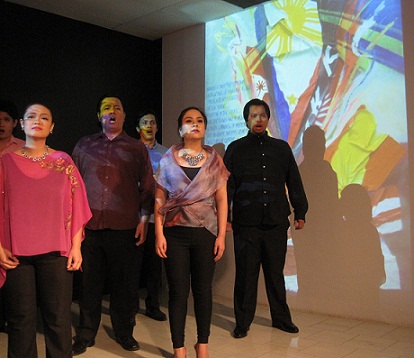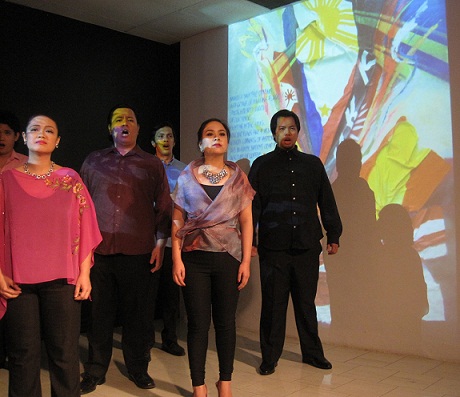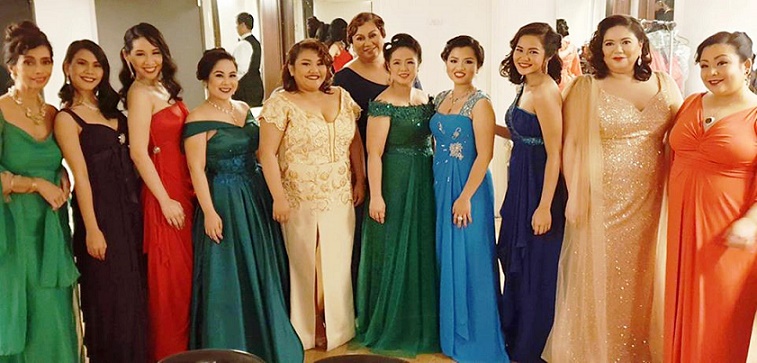Text and photos by ELIZABETH LOLARGA
MUSEUMS can no longer just be glorified warehouses or store rooms of musty artifacts, art and historical fragments. Nor must they just be tourist and education field trip destinations anymore.
Like artists and poets, they seek a more engaged connection with the public. Lopez Museum and Library is showing by example, through its current presentation “Complicated,” how an exhibition can also serve as dynamic venue for a book launch or poetry reading, fora on writing and copyright law, artists’ talks and a rousing concert, all related in some way to the exhibit theme.
The recent “Complicated the Concert,” featuring Viva Voce under soprano and music maestra Camille Lopez Molina, was a delightful ekphrasis exercise where music found a way to pay tribute to the artworks in the museum’s collection. At the same time, the contents of the afternoon’s concert were political in a sense and even if the songs went back to the age of Mozart, Schumann, Gounod, Bizet and Verdi. Who was it who said that these pieces are classical because their music is for all time? Thus do they stay evergreen, never losing their relevance.
A few words about “Complicated the Exhibition”: The phrase “it’s complicated” was popularized by social media, particularly Facebook, to describe a user’s civil status if he/she is in a complicated relationship.
The Lopez Museum show refers to the country’s complicated relationship with past colonial masters: Spain, the United States and Japan. Even if the country is the first to win its freedom, globalization, where Filipino products can hardly compete with cheaper imports, and the continued stranglehold of transnational corporations on the country prove that the ideological imprint of a foreign empire, especially of the US, remains pervasive.
 Featured are commissioned works of visual artists Mike Adrao and Leslie de Chavez and dancer-choreographer Ea Torrado. Their works (installations, paintings, videos) are sort of conversing with the museum’s collection of master works by Hidalgo, Luna, National Artists Ang Kiukok, Bencab and J. Elizalde Navarro, among others.
Featured are commissioned works of visual artists Mike Adrao and Leslie de Chavez and dancer-choreographer Ea Torrado. Their works (installations, paintings, videos) are sort of conversing with the museum’s collection of master works by Hidalgo, Luna, National Artists Ang Kiukok, Bencab and J. Elizalde Navarro, among others.
The concert was held in one of the galleries, one wall painted black to serve as stark backdrop for the performers and another painted white. On the white side to the left of the singers, the supertitles from an LCD were projected (these were the English translations of Italian, German and French songs superimposed on or side by side with images of the artworks from the current exhibit and some highly charged photos like that of Janet Napoles and a rogues’ gallery of senators).
If foreign films have subtitles, classical music concerts now have supertitles (the MCO Foundation and the Cultural Arts Events Organizer helped popularize the use of these at their Ayala Museum presentations). The practice helps the audience fully appreciate both music and lyrics without causing distraction from the performance.
After a few introductory remarks about the program selected, Lopez Molina herself accompanied Viva Voce on the piano, taking turns with Farley Asuncion. Preparations leading to the concert required a close study of the visual works on the museum walls and floors and researching on what songs were the most apt. She hoped that the audience could make the necessary connections and realize how even classical music could make pointed political commentary.
With Verdi’s provative “Va, pensiero” ( to mean “Fly, thought”) from the opera Nabucco, one could sense the enslavement not just of Jews but of all people oppressed by imperialists. The lyrics move the cynic who may think there is no deliverance from corrupt leaders: “Oh, my homeland, so beautiful and lost! / Oh memories, so dear and yet so unhappy! / Oh, harp of the prophetic seers, / Why do you hang silent from the willow?…Oh, let the Lord inspire a concert / That may give us strength to endure our suffering.”
In “Dalla sua pace,” Don Octavio’s aria from Mozart’s Don Giovanni, with lyrics like “If she sighs, then I, too, must sigh. / Her anger becomes my own. / Her tears belong to me. / And there can be no joy for me if she is not happy,” the “she” referred to is expanded to mean not just a beloved woman but a beleaguered nation that is prey to vultures and blood suckers.
There were light moments like when soprano Glenda Liao and baritone Raymond Yadao carried on a flirtation through the song “Makikiliti Kang Totoo” from the Severino Reyes zarzuela Walang Sugat. Liao brought back memories of singer-comedienne Sylvia La Torre, the
“Queen of Kundiman” during her heyday.
The soloists who stood out were soprano Myramae Meneses (great things await this new graduate of St. Scholastica’s College), tenors Ivan Niccolo Nery and Nomher Nival.
Would that Viva Voce take this same program on the road? Maybe to the halls of Congress, too?


